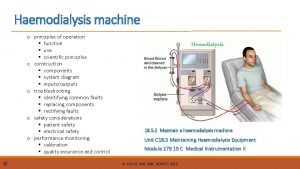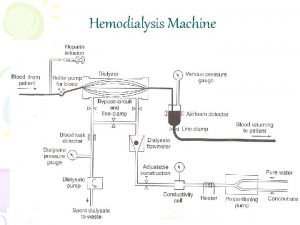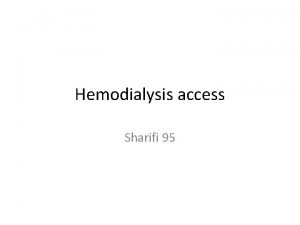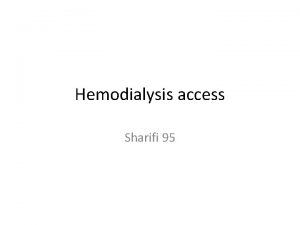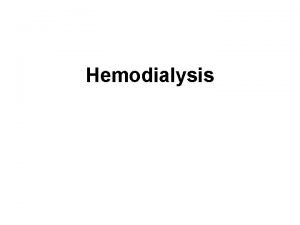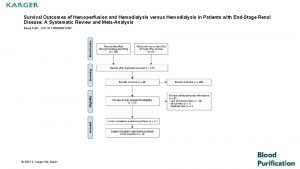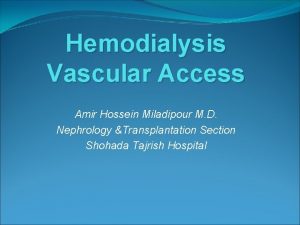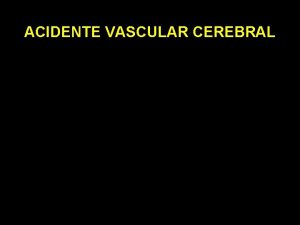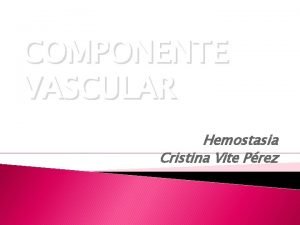Vascular Access for Hemodialysis What is a vascular






























- Slides: 30

Vascular Access for Hemodialysis

What is a vascular access? Vascular access is a hemodialysis patient’s lifeline.


What is an arteriovenous fistula? An AV fistula is a connection, made by a vascular surgeon, of an artery to a vein. AV fistula is prefered : 1. Provides good blood flow for dialysis 2. Lasts longer than other types of access 3. Is less likely to get infected or cause blood clots than other types of access

Mapping test • Before AV fistula surgery, the surgeon may perform a vessel mapping test. • Vessel mapping uses Doppler ultrasound to evaluate blood vessels that the surgeon may use to make the AV fistula.

• An AV fistula frequently requires 2 to 3 months to develop, or mature, before the patient can use it for hemodialysis.

• If an AV fistula does not mature, an AV graft is the second choice for a long-lasting vascular access

What is an arteriovenous graft? • An AV graft is a looped, plastic tube that connects an artery to a vein.


• A patient can usually use an AV graft 2 to 3 weeks after the surgery. • An AV graft is more likely than an AV fistula to have problems with infection and clotting. • Repeated blood clots can block the flow of blood through the graft. • However, a well-cared-for graft can last several year

What is a venous catheter? • A venous catheter is a tube inserted into a vein in the neck, chest, or leg near the groin, usually only for short-term hemodialysis.


What problems could a vascular access cause? • The most common problems include access infection and low blood flow due to blood clotting in the access.

How does a patient care for and protect a vascular access? • A patient can care for and protect a vascular access by ensuring that the health care provider checks the access for signs of infection or problems with blood flow before each hemodialysis treatment, even if the patient is inserting the needles.

• keeping the access clean at all times. • using the access site only for dialysis. • being careful not to bump or cut the access. • checking the thrill in the access every day. The thrill is the rhythmic vibration a person can feel over the vascular access. • watching for and reporting signs of infection, including redness, tenderness, or pus.

• not letting anyone put a blood pressure cuff on the access arm. • not wearing jewelry or tight clothes over the access site. • not sleeping with the access arm under the head or body. • not lifting heavy objects or putting pressure on the access arm

Points to Remember • A vascular access is a surgically created vein used to remove and return blood during hemodialysis. • An arteriovenous (AV) fistula is a connection, made by a vascular surgeon, of an artery to a vein.

• Health care providers recommend an AV fistula over the other types of access because it • provides good blood flow for dialysis • lasts longer than other types of access • is less likely to get infected or cause blood clots than other types of access • An AV graft is a looped, plastic tube that connects an artery to a vein.

• An AV graft is a looped, plastic tube that connects an artery to a vein. • A venous catheter is a tube inserted into a vein in the neck, chest, or leg near the groin, usually only for short-term use. • Venous catheters are not ideal for long-term hemodialysis. With a venous catheter, a patient may develop a blood clot, an infection, or a scarred vein, causing the vein to narrow. • All three types of vascular access can cause problems that require further treatment or surgery. • The most common problems include access infection and low blood flow due to blood clotting in the access.











 Hemodialysis machine parts and function
Hemodialysis machine parts and function Hemodialysis cito indication
Hemodialysis cito indication Urea reduction ratio formula
Urea reduction ratio formula Sequential ultrafiltration vs hemodialysis
Sequential ultrafiltration vs hemodialysis Hemosorption vs hemodialysis
Hemosorption vs hemodialysis Hemodialysis machine parts and function
Hemodialysis machine parts and function Life cycle of seedless plants
Life cycle of seedless plants Vascular and non vascular difference
Vascular and non vascular difference Nonvascular plants reproduction
Nonvascular plants reproduction Terminal access controller access-control system
Terminal access controller access-control system Terminal access controller access-control system
Terminal access controller access-control system Kyssande vind analys
Kyssande vind analys Vem räknas som jude
Vem räknas som jude Skivepiteldysplasi
Skivepiteldysplasi Tack för att ni lyssnade bild
Tack för att ni lyssnade bild Romarriket tidslinje
Romarriket tidslinje Shingelfrisyren
Shingelfrisyren Vad är verksamhetsanalys
Vad är verksamhetsanalys Tack för att ni har lyssnat
Tack för att ni har lyssnat Stål för stötfångarsystem
Stål för stötfångarsystem Vad står k.r.å.k.a.n för
Vad står k.r.å.k.a.n för Centrum för kunskap och säkerhet
Centrum för kunskap och säkerhet Läkarutlåtande för livränta
Läkarutlåtande för livränta Texter för hinduer tantra
Texter för hinduer tantra Inköpsprocessen steg för steg
Inköpsprocessen steg för steg Påbyggnader för flakfordon
Påbyggnader för flakfordon Egg för emanuel
Egg för emanuel Strategi för svensk viltförvaltning
Strategi för svensk viltförvaltning Sura för anatom
Sura för anatom Stickprovsvarians
Stickprovsvarians Rutin för avvikelsehantering
Rutin för avvikelsehantering
